
With cold temperatures, short days, lots of snow and an almost endless number of potential routes, a first winter trip to the Mont Blanc Massif can end up being little more than a difficult wallow in deep powder snow followed by failing on an out of condition route.
However with a bit more knowledge, often with a pair of skis, and by keeping an eye on conditions and snow depth, you can actually have relatively straight-forward and single day adventures in the Mont Blanc Massif.
Warm clothes, winter climbing experience, glacier travel knowledge and avalanche awareness are all required, but if you have those and fancy some routes, here are ten suggestions that are (in the right conditions) good bets for a winter ascent.
NB. These routes are not '10 routes for absolute beginners'. This is a list for the competent Alpinist, you need to be able to move around, and climb ice and mixed terrain to get up these climbs, and experience of climbing Scottish Grade V would be a good start, but we'll all agree that you certainly don't need to be Ueli Steck to climb the Chere Couloir!
Login as Existing User to subscribe, which will show the climbs you've already ticked.
| Add | Climb name | Grade | Height | Crag name | |
|---|---|---|---|---|---|
| Fil à Plomb | TD 4+ *** | 700m | Aiguille du Plan | ||
| Modica-Noury | TD+ 5+ *** | 500m | Mont Blanc du Tacul | ||
| Gabarrou-Albinoni | TD 4+ *** | 500m | Mont Blanc du Tacul | ||
| Chèré Couloir | D 4 *** | 350m | Mont Blanc du Tacul | ||
| Profit-Pérroux | TD 4+ *** | 300m | • 5 | Aiguille du Midi | |
| Vent du Dragon | TD 5 *** | 250m | Aiguille du Midi | ||
| Ice is Nice | TD *** | 500m | Dent du Requin | ||
| Rebuffat Gully | TD 5 ** | 350m | Tour Ronde | ||
| Frendo-Ravanel | TD- 4+ ** | 500m | L'Aiguille... | ||
| Petit Viking | TD- 4 *** | 400m | Mont Dolent | ||
28 stars |
4,350m, 14 pitches | ||||
Hidden, Hidden
Fil à Plomb (TD) (III 4+ 700m) Rognon du Plan North Face
A route with the easiest descent in the Alps (cable car!) and a good bet for those who don't ski. This climb is fairly easy to access from the Plan de l'Aiguille midstation of the Aiguille du Midi cable car.
Weaving its way up to the left of the North Face of the Aiguille du Midi (as you're looking up from the valley) it climbs a series of snow slopes at the top and the bottom of the face - with some brilliant ice pitches in the middle - to land you between the Rognon du Plan (on the left) and the Col Du Plan (on the right). From the summit it (depending on snow conditions) is a straightforward ridge ascent (part of the Midi-Plan Traverse) to the Aiguille du Midi cable car station, and a stress-free ride back to beer and cake in the valley.
Mostly the ground is quick and easy to cover, and the pitches in the middle weigh in at around Scottish 4 or 5 (all depending on condions of course). The added bonus with this route is that if you know where to look you can easily spot the ice pitches from the town, giving you a good idea of conditions before you even leave the comfort of the bar.
Be warned though, in bad weather and deep snow the ridge to gain the Aiguille du Midi has been known to take people a VERY long time. Probably better to stay in the valley in these conditions - regardless of the route!
Often if the snow cover isn't that deep on the Plan de l'Aiguille you won't have much bother just walking in wearing your winter mountaineering boots, but if there is loads of snow then taking snow shoes could be useful. Also people do sometimes carry skis on this climb so that they can just whizz off the back when they top out and ski the Grand Envers variation to reach the Vallée Blanche.
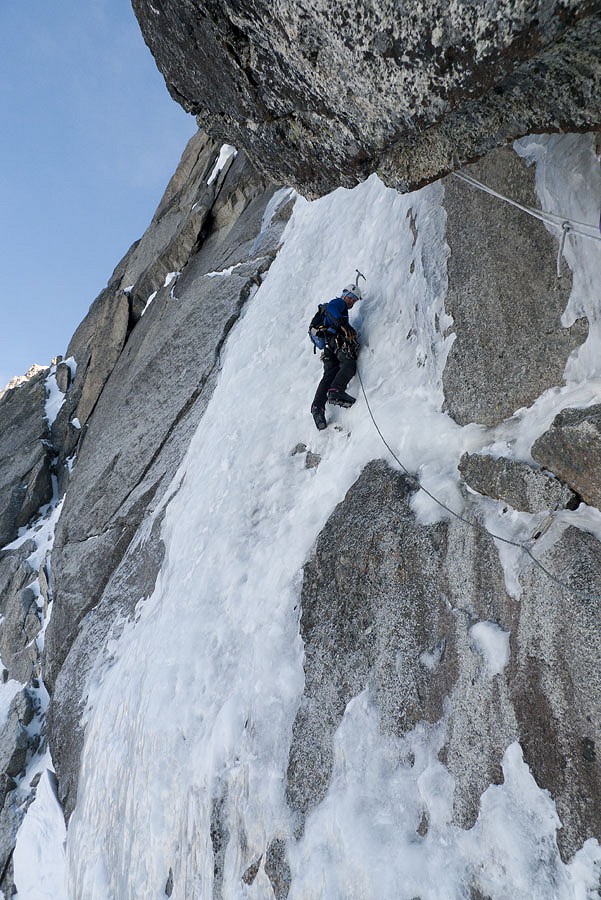
Modica-Noury (TD+) (III 5+ 500m) / Gabarrou-Albinoni (TD) (III 4+ 500m) Mont Blanc Du Tacul
These two are classic Alpine goulotte routes, and perfect for a single day hit with skis. Super fast access on skis from the Aiguille du Midi cable car (who doesn't like a downhill approach?!) and then a down hill ski out to the bottom of the Vallée Blanche.
The climbing and route finding is quite straight-forward on both routes, you just follow the obvious ice gully! The Modica-Noury is slightly harder and steeper than its neighbour, but with modern tools and screws, and in good conditions, competent ice climbers should be able to climb them quite quickly.
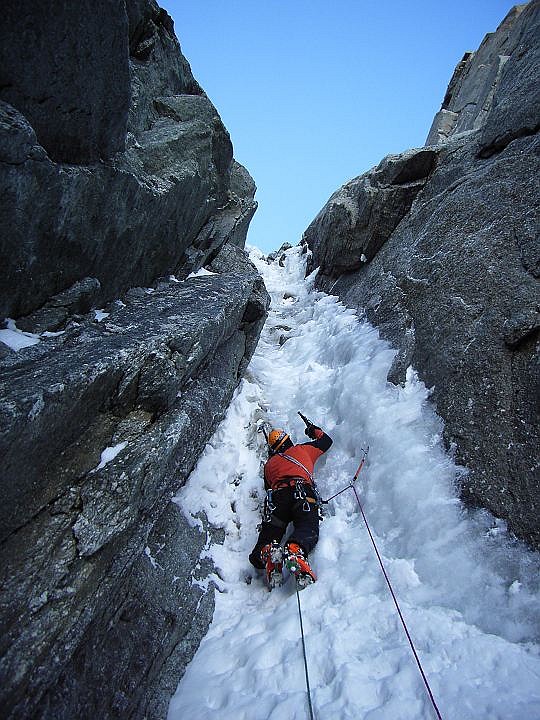
The routes are equipped for abseil a pitch or 2 below the top, as this is where the obvious ice lines end, and this is where most parties to choose to retreat from.
Choosing to abseil off means that you can easily reach your skis without having to do any glacier-wading, and means you can set off down the Vallée Blanche and back to Chamonix. Bear in mind that often the snow line doesn't reach all the way to the valley bottom, so you will have to stop skiing at the Montenvers / Mer de Glace Train Station. You can either then take the train down (wow you were quick!) or if it is evening by that time then a brutal hike down to the valley floor carrying skis etc will take you a bit under 2 hours.

You can guarantee to make the Montenvers train, and give yourself a much less time constrained day if you opt for a night in the Requin Hut halfway down the Vallée Blanche. This does add to the time and expense, but it is a great way to spend the night, the food is fantastic, and then you can do an early ski down the bottom half of the Vallée Blanche with no one around - quite a rarity on Europe's most famous off piste ski run.
- More info on the Requin Hut: refugedurequin.ffcam.fr
Chèré Couloir (D 4) (II 4 350m) Mont Blanc Du Tacul (Triangle)
Climbable all year round, this little beauty is very accessible in winter and a good first bet for winter Alpinism if you're more used to Scottish climbing than Alpine ridge walking. It is easily approached with snowshoes if you don't ski.
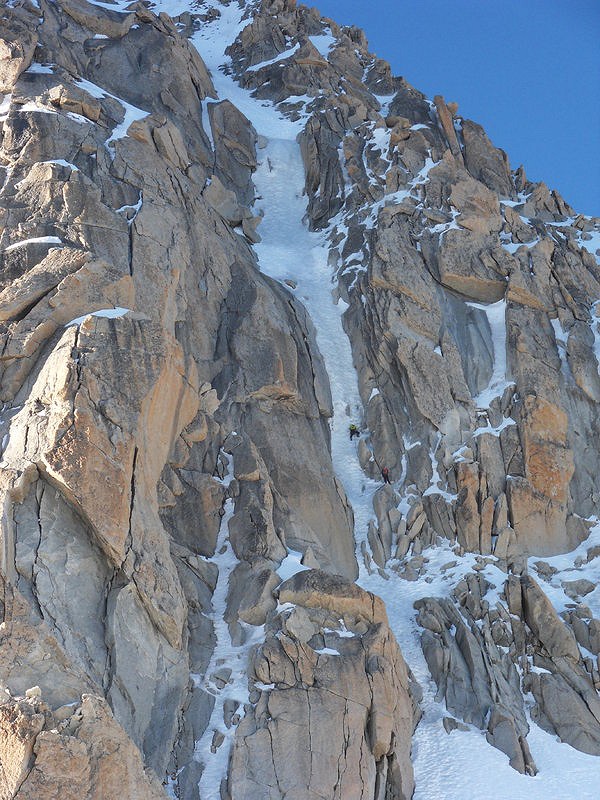
The classic ice gully is found on the right side of the Tacul Triangle, just a relatively short walk from the Aiguille du Midi cable car station. Remember though you are crossing a glacier, even if there is a well used track in the snow.
The climbing and situation are great, however this route does get busy - you have been warned!
It's a nice ice gully, with fixed belays on the flanks. The usual way to descend is to abseil off at the end of the difficulties, and either trudge back to the Aiguille du Midi (not far, but remember going uphill at altitude can be slow if you are unacclimatised!) or you can ski down the Vallée Blanche.
A competent party should have no problems with doing this route 'bin to bin' taking the first cable car up the mountain and making it back to take the last cable car. However if this is your first time up The Midi, then you might want to check out the lay of the land, make sure you're acclimatised, and have your glacier travel all sorted before going for it, or a cold night 'sleeping' at the cable car station awaits you!
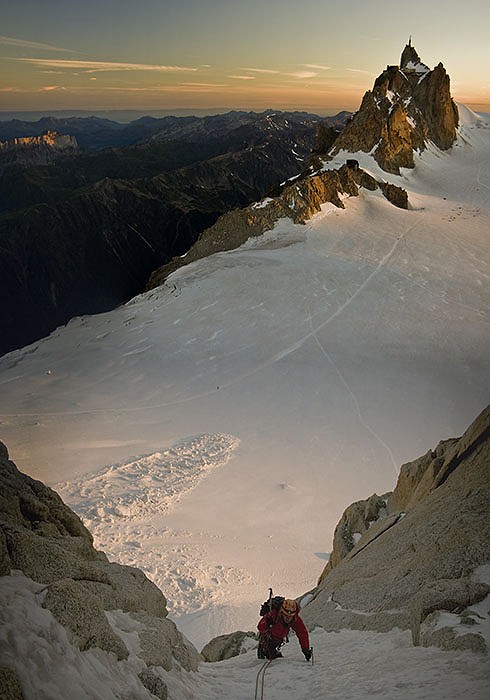
For those who don't want to rush, or want to beat the crowds by starting early, then a night at the Abri Simond bivouac hut might be the ticket. This is a basic and quite scruffy box close to the larger and posher (and closed in the winter) Refuge de Cosmiques. The Abri Simond sleeps around 10 people.
Profit-Pérroux (TD) (II M5 3 250m) / Vent du Dragon (TD 5) (II M4 3 250m) Aiguille du Midi
Zero metres walk-in means these convenient routes are great when the weather or snow conditions make mountain travel difficult.
Accessed from the top of the Aiguille du Midi cable car via a series of abseils (the first one being quite 'out there' - a free hanging 60m straight off the bridge!), these two routes are relatively short, quite technical and top out just before the crux wall of the famous Cosmique's Arete, which is then followed back to the cable car station.
Competent parties should have no trouble climbing these routes 'bin to bin' but they are harder when thin, so getting an idea of the conditions before you go is a good idea.
Despite their relative ease of access and my previous statement.... there are a few parties I know who have 'enjoyed' a cold night in the Midi toilets after either going off route or just simply being too slow to catch the last lift down - ah the joy of cable car Alpinism! Don't get it wrong!
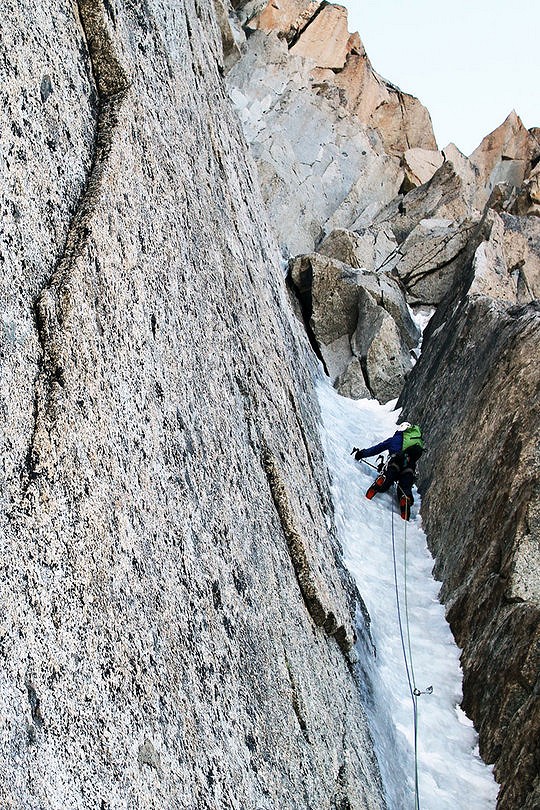
Ice is Nice (TD) (III 5 500m) Dent du Requin
Getting a little bit further down the Vallée Blanche we find this brilliant and often quiet ice climb.
Although the approach is a little longer than some of the other routes in this list, for the fast ski-alpinist is still doable in a day, especially if you are happy to ski out down the Vallée Blanche by head torch (which if you are anything like me, you will get to practice a lot!).
Ice is Nice is on the North Face of the Dent du requin, which is accessed from the Envers de Blatiere glacier. It follows an almost picture perfect runnel of ice and is often in condition in winter.
The route does traverse at the top, but most teams just abseil before this traverse, at the end of the difficulties, meaning the abseil descent is easier to manage. There are several similar lines in this area, all of which are fantastic.

Rebuffat Gully (TD 5) (II 4 M4 350m) Tour Rond
Ease of access from the Torino hut / Helbronner lift station or the Aiguille du Midi means this brilliant route is also climbable in a day, and it is the only one on the list to reach a wild summit!
Okay, okay, getting the Helbronner lift means starting in the Italian side of the Mont Blanc Range (drive through the Mont Blanc tunnel from Chamonix), but it does open this route up to those who want to approach on snow shoes instead of skis, but of course it is also perfectly possible to ride the Aiguille du Midi cable car and ski from there to the Combe Maudit in around the same amount of time. Either option 'should' leave you enough time to do the route in a day, as long as you're quick!
The route has bolted belays and the descent is by abseil. The climbing is a mixture of sections of ice and snow with occasional mixed sections of around M4. The route is easier when it has more ice.
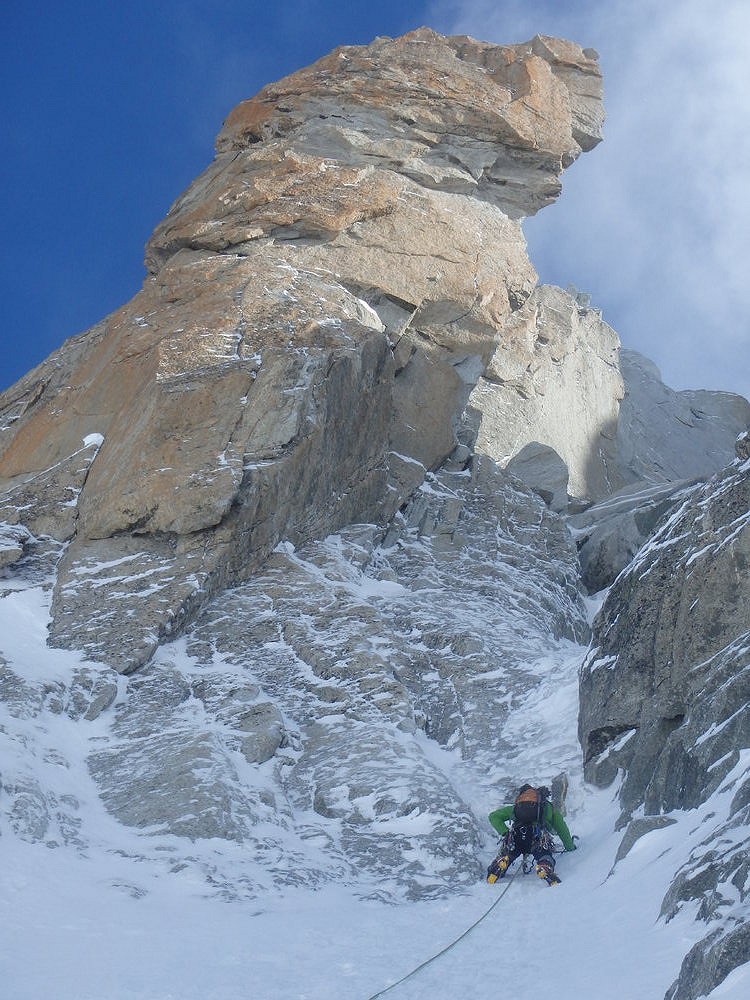
Frendo-Ravanel (TD-) (II 5 500m) Aiguille Carree
Ease of access and great climbing make this a popular choice and it can be accessed with or without skis.
Literally approached in 5 minutes from the top of the Grands Montets cable car, this now classic route is popular, and rightly so. It climbs a series of snow gullies and ice flows to the col between the Aiguille Carrée and the Pointe Farrar, which is part of the Grands Montets ridge.
The route is descended by abseil, straight back to your skis, and then a short ski back to the Grands Montets ski area. The crux is usually an ice section 80-90° or if the ice is thin it can be climbed as a mixed section with good gear in the side walls.
It can be quite confusing finding the base of the route as you traverse the slope towards the Aiguille Verte, as much of the broken ground and gullies above look similar, and there are several similar routes in this area, but a good reference is that the Frendo-Ravanel starts up the large snow bay after the lowest rock tongue, well before you reach the Cordier Couloir on the Verte.
The fast approach can make this feel like little more than cragging, but remember the route is still 500m long, and is over 3000m altitude, so it is still a serious undertaking. The day the photo was taken was bitterly cold (-20°c) and another party got severe frost-bite in their feet from climbing in lightweight boots. Remember this is winter Alpinism we are talking about here!
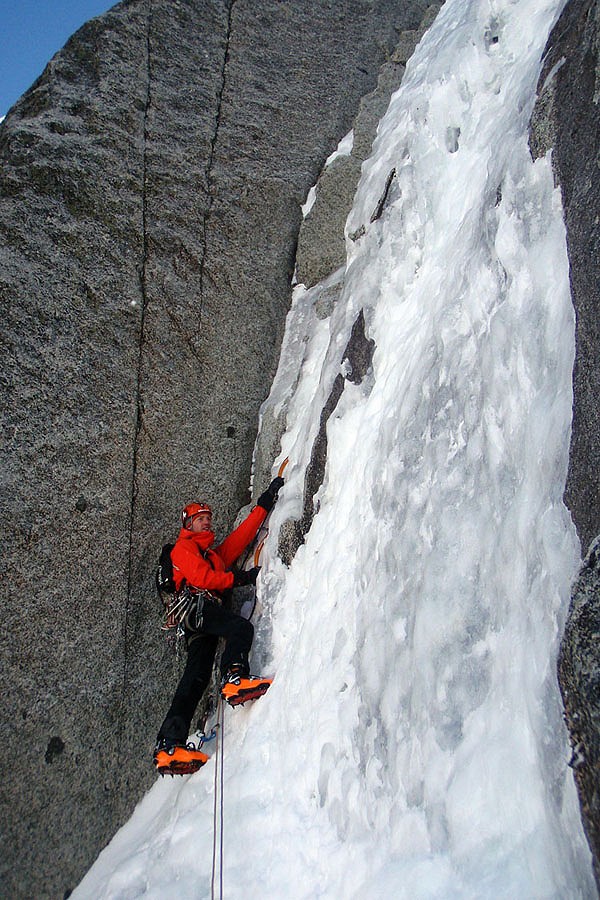
Petit Viking (TD- 4) (III,4 500m) Pointe du Domino
Right at the head of the Argentiere glacier, this majestic ice climb is almost as good as the ski tour in and out!
Often the crux of this route is the bergshrund which can be huge and impossible to cross, but if you have the chance to go and look, or if you've heard it's good, then this beautiful route won't disappoint.
The climb itself follows snow slopes and an ice line, and is never desperate but is continuously interesting with a short section of icy mixed climbing near the top of the difficulties.
Again this is a climb that a fast team can do in a day on skis, but the approach up the Argentiere Glacier is long, even if it isn't steep, so make sure you're fit or even if you do get there in good time you might be too knackered to climb anyway! A night in the Argentiere Hut winter room can make the outing much less stressful.
The descent from the route is by abseil, and the ski out down the whole Argentiere Glacier is magnificent. If you're planning to ski out late at night it can be a good idea to know the track out of the bottom of the glacier (it gains the piste at Grands Montets) as it can be a real rabbit run by headtorch.
Jack Geldard holds the Mountain Instructors Award is also currently going through the British Mountain Guide's training scheme.
He has climbed in 5 of the 7 continents, up to a very high level, and enjoys all forms of climbing, from winter alpinism (hence this article!) through to summer bouldering. He's still not overly keen on falling off though...
His particular favourite styles of climbing are UK seacliffs, classic Alpinism, and multipitch sport climbs. Or pretty much anywhere sunny.
- You can read a little more about him, his climbing, and his guiding on his own website: Jackgeldard.com
More Articles



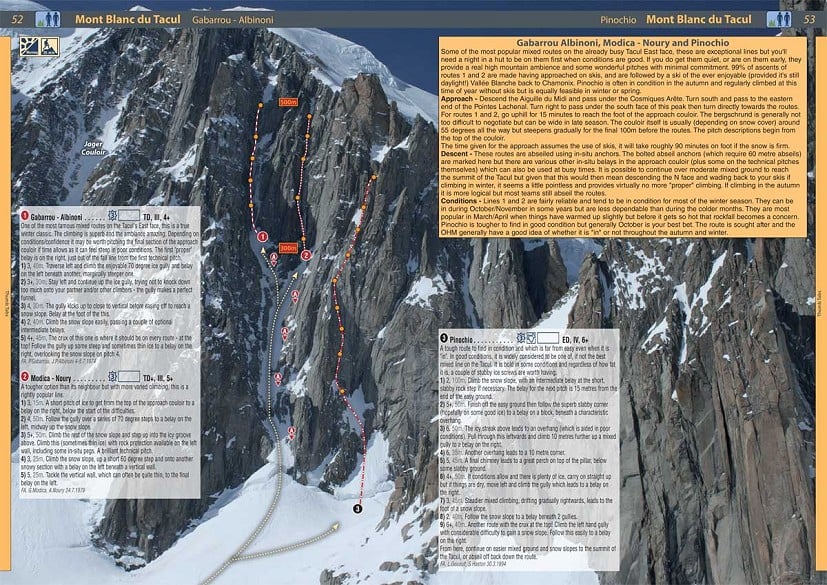

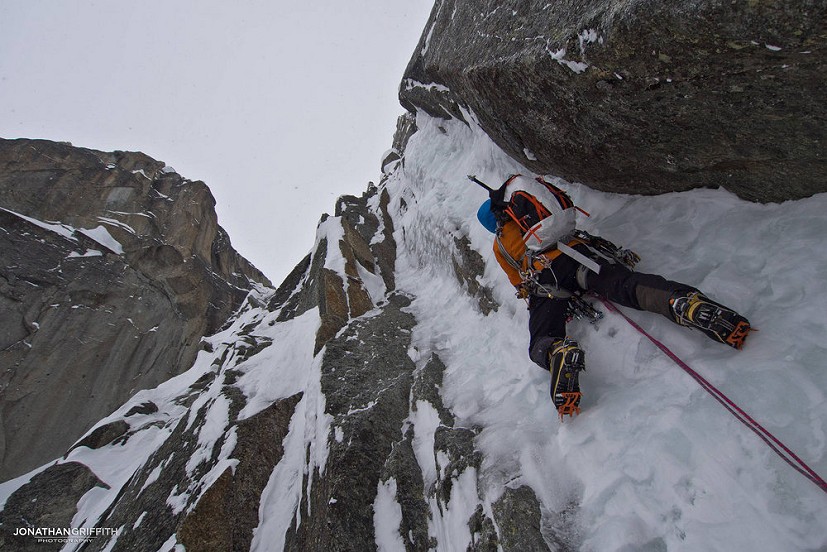
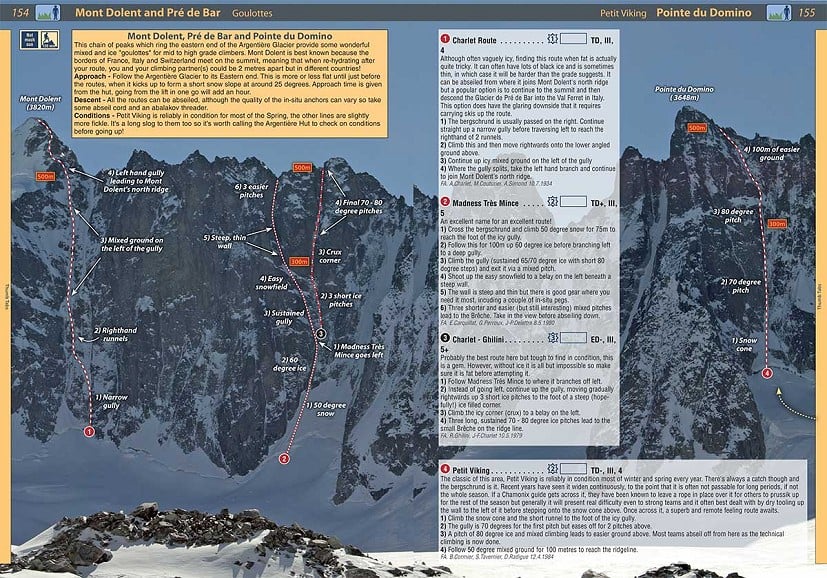
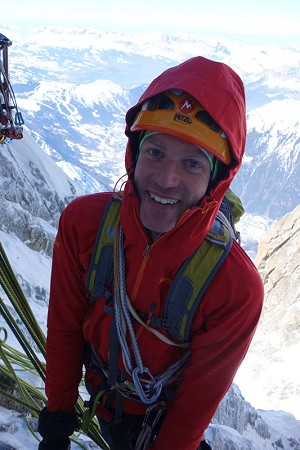
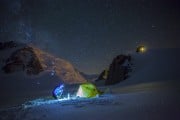

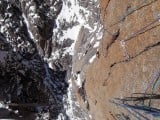


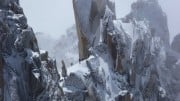
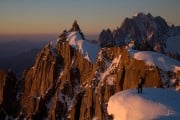

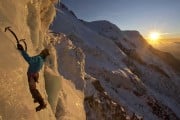

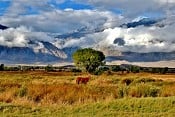
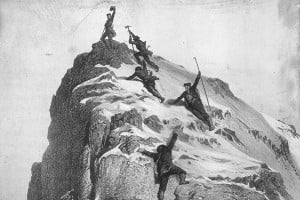
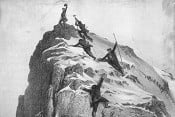





Comments